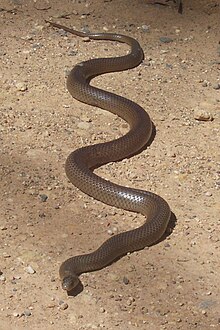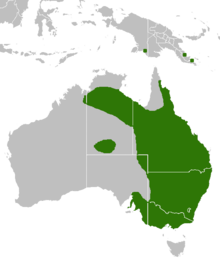| Eastern brown snake | |
|---|---|

| |
| Eastern brown snake, NSW, Australia | |
| Scientific classification | |
| Domain: | Eukaryota |
| Kingdom: | Animalia |
| Phylum: | Chordata |
| Class: | Reptilia |
| Order: | Squamata |
| Suborder: | Serpentes |
| Family: | Elapidae |
| Genus: | Pseudonaja |
| Species: | P. textilis
|
| Binomial name | |
| Pseudonaja textilis | |

| |
| Range of eastern brown snake (in green) | |
| Synonyms[2][3] | |
|
List
| |
The eastern brown snake (Pseudonaja textilis), often referred to as the common brown snake, is a species of extremely venomous snake in the family Elapidae. The species is native to eastern and central Australia and southern New Guinea. It was first described by André Marie Constant Duméril, Gabriel Bibron, and Auguste Duméril in 1854. The adult eastern brown snake has a slender build and can grow to 2 m (7 ft) in length. The colour of its surface ranges from pale brown to black, while its underside is pale cream-yellow, often with orange or grey splotches. The eastern brown snake is found in most habitats except dense forests, often in farmland and on the outskirts of urban areas, as such places are populated by its main prey, the house mouse. The species is oviparous. The International Union for Conservation of Nature classifies the snake as a least-concern species, though its status in New Guinea is unclear.
It is considered the world's second-most venomous land snake after the inland taipan (Oxyuranus microlepidotus), based on its LD50 value (subcutaneous) in mice.[a] The main effects of its venom are on the circulatory system—coagulopathy, haemorrhage (bleeding), cardiovascular collapse, and cardiac arrest. One of the main components of the venom is the prothrombinase complex pseutarin-C, which breaks down prothrombin.
- ^ Tallowin, O.; O'Shea, M.; Parker, F.; Greenlees, M.; Shea, G. (2018). "Pseudonaja textilis". IUCN Red List of Threatened Species. 2018: e.T42493315A42493324. doi:10.2305/IUCN.UK.2018-1.RLTS.T42493315A42493324.en. Retrieved 25 June 2022.
- ^ Australian Biological Resources Study (26 August 2013). "Species Pseudonaja textilis (Duméril, Bibron & Duméril, 1854)". Australian Faunal Directory. Canberra, Australian Capital Territory: Department of the Environment, Water, Heritage and the Arts, Australian Government. Archived from the original on 2 May 2019. Retrieved 24 October 2017.
- ^ Species Pseudonaja textilis at The Reptile Database http://www.reptile-database.org Archived 2001-11-07 at the Wayback Machine.
- ^ "Are Australian snakes the deadliest in the world? Not even close". The Conversation. The Conversation Grp Ltd. 11 January 2016. Archived from the original on 11 December 2018. Retrieved 4 December 2018.
Cite error: There are <ref group=lower-alpha> tags or {{efn}} templates on this page, but the references will not show without a {{reflist|group=lower-alpha}} template or {{notelist}} template (see the help page).
